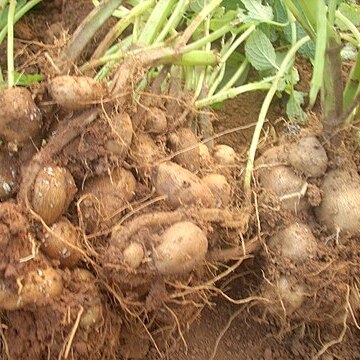A herb or small shrub. It keeps growing from year to year. It grows 60 cm high. It can lie along the ground. It loses it leaves during the year. The leaves are fleshy and opposite. They are 5-8 cm long by 1-3 cm wide. They are narrowly oval. There are rounded teeth along the edge. The stems are angular. Some of the branches near the base bend down and grow into the ground to form long tubers. They grow from a central point like fingers on a hand. The tubers grow in clusters and are large. They can be 10 cm long and 2 cm wide. The flowers are yellow. They have a faint smell of tar.
Rather coarsely pilose with whitish hairs
Perennial with herbaceous erect stems
Flowers yellow 1/2-2/3 in. long
Root elongated-tuberous
Often cultivated.

